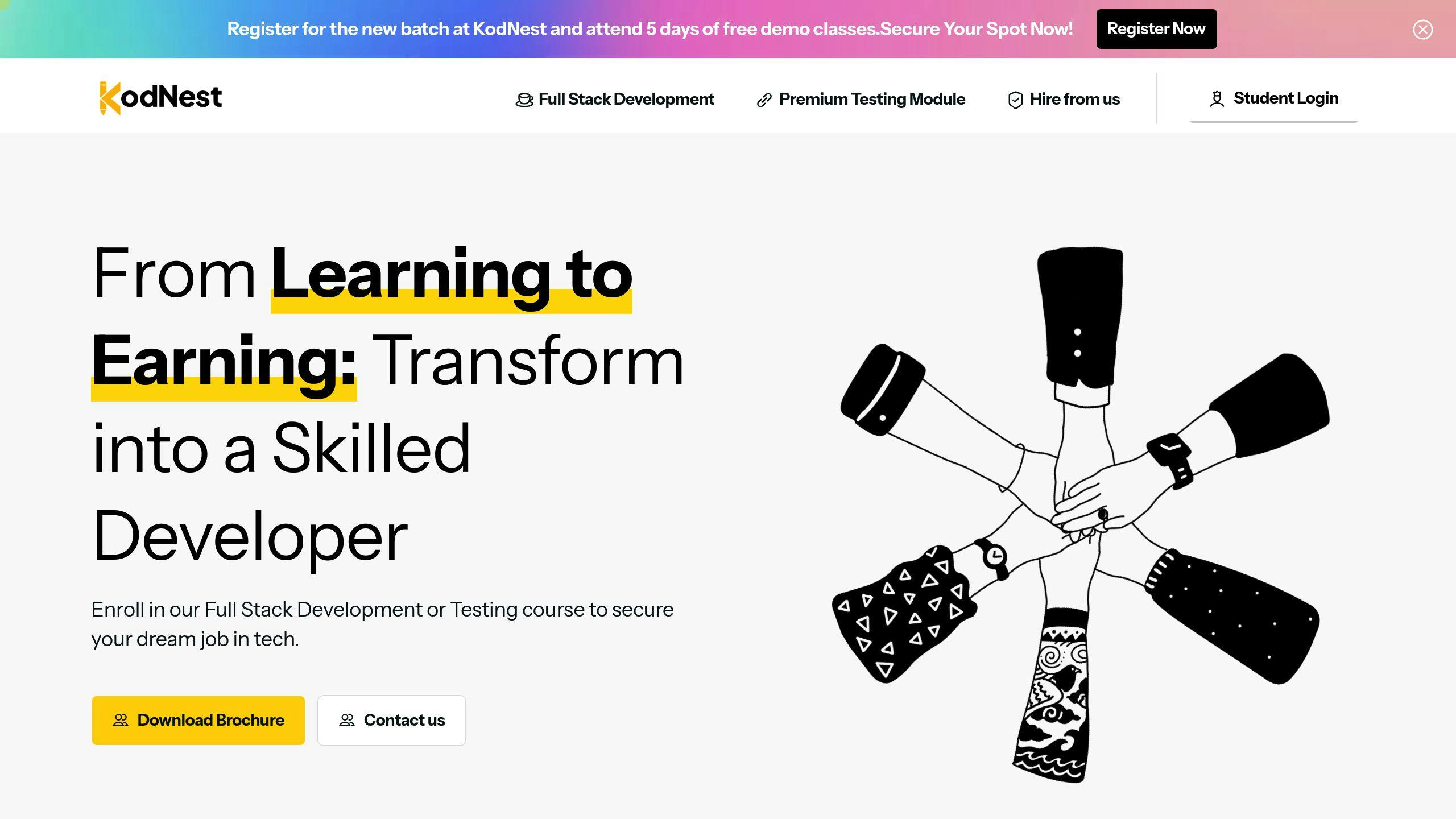Here’s what you need to know:
- What is the H-1B visa?: It lets U.S. companies hire foreign professionals for specialized roles, like full stack development.
- Who qualifies?: You need a bachelor’s degree (or higher) in a relevant field, advanced technical skills, and a job offer from a U.S. employer.
- How competitive is it?: Only 85,000 visas are issued yearly, while registrations in 2023 hit nearly 484,000.
- What’s the process?: Employers file an LCA and petition on your behalf. The timeline includes registration in March, lottery selection in April, and potential work start by October.
- Key skills to highlight: Front-end (React, JavaScript), back-end (Node.js, Python), database management (SQL, MongoDB), and cloud services (AWS, Google Cloud).
- Salary insights: Average pay for H-1B full stack developers is $114,140/year, with higher ranges in cities like San Francisco and Seattle.
Pro tip: Start preparing 6-7 months in advance, and consider premium processing for faster results. Immigration attorneys can also help ensure your application is accurate and compliant.
Ready to dive deeper? Let’s break down the process step by step.
H-1B Visa Eligibility for Full Stack Developers
Basic Requirements for H-1B Visa
Full stack developers seeking an H-1B visa must meet several key requirements. These include holding a bachelor’s degree in computer science or a related field, possessing advanced technical skills, and securing a job offer from a U.S. employer. The position must demand specialized knowledge. Keep in mind, competition is tough – only 85,000 visas are issued annually, with 20,000 reserved for those holding advanced degrees [1].
Full Stack Development as a Specialty Occupation
Full stack development qualifies as a specialty occupation due to its technical demands and the need for expertise across various domains. Here’s a breakdown of the required skills:
| Technology Layer | Skills Needed |
|---|---|
| Front-end | Proficiency in JavaScript frameworks, HTML5, CSS3, and UI/UX principles |
| Back-end | Knowledge of server-side programming, API development, and system architecture |
| Database | Experience with SQL/NoSQL databases, data modeling, and optimization |
| DevOps | Familiarity with version control, deployment processes, and cloud services |
This broad and technical skill set underscores the need for a bachelor’s degree or higher, making full stack development a recognized specialty occupation [1][5]. U.S. employers value these highly sought-after skills, which increases the demand for full stack developers as H-1B candidates.
Role of Employer Sponsorship
Employer sponsorship is a critical part of the H-1B process. It involves filing a Labor Condition Application (LCA) with the Department of Labor, submitting the H-1B petition to USCIS, and demonstrating that the role meets the specialty occupation criteria while adhering to wage requirements. Standard processing times range from 3 to 5 months, but employers can opt for premium processing at $2,500 to receive a response within 15 days [2][4].
Navigating this process can be challenging. Employers are strongly encouraged to work with an experienced immigration attorney to ensure all documentation complies with USCIS standards. This guidance can help avoid common errors and improve the likelihood of a successful application [1].
Understanding these criteria is a crucial first step before diving into the application process.
H1B Visa Explained, Simply
Steps to Apply for an H-1B Visa
After confirming eligibility, full stack developers need to follow a structured process to apply for an H-1B visa.
Documents Needed for the Application
Applicants must gather all necessary documents to complete their application:
| Document Type | Details Required |
|---|---|
| Educational Records | Degree certificates, transcripts |
| Professional Documents | Resume, certifications, recommendation letters |
| Identity Documents | Passport, photos, birth certificate |
| Employment Documents | Job offer letter, contract, salary details |
| Technical Portfolio | Project documentation, code samples |
Employer’s Role in Filing the Petition
Employers play a critical role in the H-1B process by completing these two steps:
- Labor Condition Application (LCA): The employer submits an LCA to the U.S. Department of Labor to confirm the position adheres to wage and workplace standards [2].
- H-1B Petition Filing: The employer files Form I-129 with USCIS, providing evidence that the job qualifies as a specialty occupation [6].
Timeline and Important Dates
The H-1B application process follows a specific yearly timeline:
| Phase | Timing | Action |
|---|---|---|
| Initial Registration | March | H-1B Registration |
| Lottery Selection | Late March/Early April | Random Selection |
| Petition Filing | April | File Petitions |
| Processing Period | 3-6 months | USCIS Review |
| Start Date | October 1 | Employment Begins |
To stay on track, start preparing at least seven months before your intended start date [2].
"It is crucial to consult with an experienced immigration attorney or immigration professional to ensure all aspects of the H-1B visa application are properly addressed" [1].
sbb-itb-f454395
Career Paths for Full Stack Developers with H-1B Visas
Finding Jobs with H-1B Sponsorship
Platforms like LinkedIn and Indeed list many full stack developer roles that offer H-1B sponsorship. To narrow your search, use filters specifically for sponsorship opportunities and focus on companies known for supporting H-1B applications. Additionally, networking through tech groups, conferences, or even virtual events can help you discover opportunities that aren’t always advertised.
| Job Search Strategy | Tips for Success |
|---|---|
| Online Platforms | Use "H-1B sponsorship" filters on LinkedIn, Indeed |
| Direct Applications | Research companies with a record of H-1B support |
| Networking Opportunities | Attend tech events, join groups, and engage online |
Once you’ve identified potential employers, make sure to emphasize the technical skills that set you apart and align with H-1B requirements.
Key Skills to Highlight
To stand out, showcase your strengths in front-end and back-end development, database management, and cloud technologies. These areas align with the qualifications for H-1B specialty occupations. Demonstrating these capabilities not only boosts your application but also supports your H-1B petition by proving the technical nature of your role.
| Technical Area | Skills to Emphasize |
|---|---|
| Front-end Development | JavaScript, React, Angular, Vue.js |
| Back-end Technologies | Python, Java, Node.js |
| Database Management | SQL, MongoDB, PostgreSQL |
| Cloud Services | AWS, Azure, Google Cloud |
| Architecture | System design, distributed systems |
Salary Trends for H-1B Full Stack Developers
Full stack developers on H-1B visas earn competitive salaries, with an average of $114,140 per year. In tech-heavy cities like San Francisco, New York, and Seattle, salaries can range from $130,000 to $180,000 [5]. Knowing these benchmarks can help you negotiate better offers and evaluate the worth of specific opportunities. These salary figures highlight the demand for skilled developers in the U.S., making the H-1B visa a worthwhile path to explore.
Advice and Resources for H-1B Success
Getting Ready for the Application
Once you’ve landed an H-1B job offer, preparation is your next big step. Start organizing essential documents at least six months before your planned start date. Gather educational transcripts, proof of work experience, and any technical certifications that highlight your skills. A well-prepared portfolio showcasing your full stack development expertise can also make your application stand out.
If time is of the essence, consider premium processing. For an additional $2,500, you’ll receive a decision within 15 calendar days – perfect for urgent job offers [2].
KodNest: Training for Full Stack Developers

Building your technical skills not only improves your job opportunities but also highlights the specialized expertise required for H-1B approval. KodNest offers practical training tailored for full stack developers, helping candidates meet H-1B specialty occupation standards. They also provide job placement assistance, connecting you with potential sponsoring employers.
Working with Immigration Experts
Technical skills alone won’t get you through the H-1B process – understanding the legal side is just as important. Immigration attorneys can guide you through the complexities, ensuring your paperwork is accurate, deadlines are met, and regulations are followed. Their support can help you avoid status violations and minimize the chances of delays or denials.
"It is crucial to consult with an experienced immigration attorney or immigration professional to ensure all aspects of the H-1B visa application are properly addressed" [1].
Once your H-1B is approved, staying compliant is key. Stick to the terms of your employment and keep all immigration documents up to date [1]. Regular check-ins with your attorney can help you stay on top of visa requirements and avoid potential issues.
Final Thoughts
Key Takeaways
Navigating the H-1B process as a full stack developer takes careful planning. From ensuring you meet basic requirements like holding a bachelor’s degree and securing sponsorship, to understanding timelines that could vary from several months to just 15 days with premium processing, preparation is crucial. Highlighting skills in distributed systems and end-to-end solutions is especially important, as these align well with the H-1B specialty occupation criteria [3]. The technical nature and complexity of the role make it a strong option for developers aiming to work in the U.S.
What to Do Next
Start early by gathering the essential documents mentioned earlier in this guide [2]. Strengthen your application by following the tips and requirements shared in previous sections. Consider boosting your skills through structured programs like those from KodNest, which offer a mix of hands-on projects, a detailed curriculum, and AI-driven mentorship to help you stand out to employers offering H-1B sponsorship.
This guide has broken down the steps and requirements for navigating the H-1B process. Now it’s up to you to take action and set yourself on the path to securing a full stack development role in the U.S. With the right preparation, you can make it happen.





